Besshipless sweet and sour gooseberry variety Russian yellow
The garden season is hot, so many gardeners choose varieties that do not require complex care. Gooseberry Russian yellow is distinguished by its unpretentiousness, undemanding to the water regime, and tolerates wintering well. But before planting, you need to study its characteristics and growing rules. In this article you will find a description of the Russian yellow gooseberry, learn about its advantages and disadvantages.
The content of the article
Gooseberry variety Russian yellow
The variety with an average ripening period is recommended for growing in the North-West and Ural regions. The yield is high - up to 4 kg per bush. Differs in low berry crumbling. Does not require formative pruning. At a young age, he needs a garter to support.
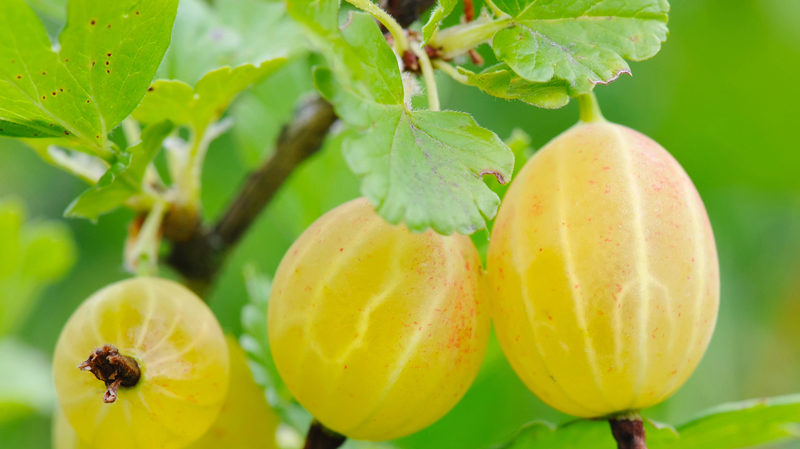
History of origin and distribution
Bred in the All-Russian Research Institute of Horticulture. Michurin in the 70s. last century. To obtain the variety, the method of clonal selection was used. Initial varieties - Russian, Curry, Oregon, Shtambovy.
Despite the recommended zoning, high drought tolerance contributed to the widespread distribution of Russian yellow also in the southern regions.
Characteristics and description of the bushes
The bush is medium spreading. Old shoots of light color, about 1 m high. Young ones are thick, green with a reddish, hairless top. Thorniness is high in the lower part of the bush, low at the tops of the shoots.
Resistant to temperatures
Withstands temperatures down to -28 ° C without shelter.
Moisture and drought resistance
Drought resistance is high, but long-term lack of moisture affects the yield. Moisture resistance is low, with prolonged waterlogging of the root system, the risk of infection with fungal diseases and damping out of the root system.
Disease and pest resistance
The variety is resistant to American powdery mildew.
Affected by:
- spider mite;
- fire flare;
- anthracnose;
- rust.
Despite good immunity, it is possible to get infected with viral diseases, for example, viral mosaic of leaves. New seedlings are kept in quarantine for at least a month.
Characteristics and description of fruits
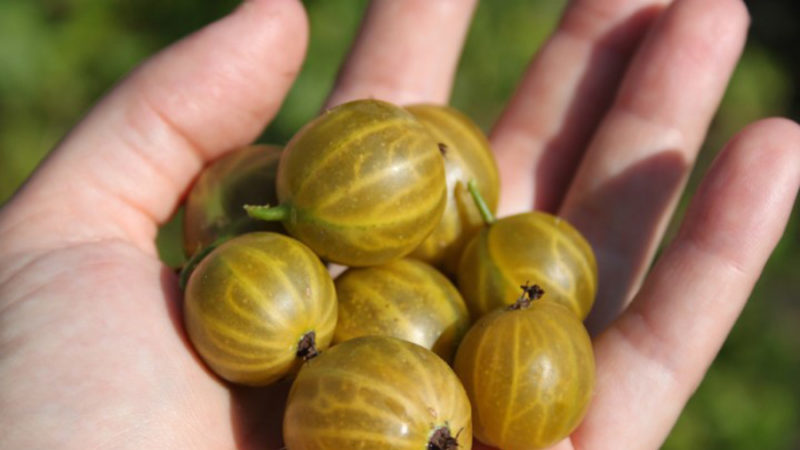
Berries weighing up to 6 g, ovoid or oval. No pubescence. Color in various shades of yellow. The fruits are covered with a waxy coating. The skin is of medium thickness, the venation is high. The taste is sweet and sour.
Areas of use
The use of fruits is universal. They are used in cooking for the preparation of desserts, sauces and preparations for the winter. Also eaten fresh.
Advantages and disadvantages compared to other varieties and hybrids
Benefits of Russian Yellow Gooseberry:
- high drought resistance;
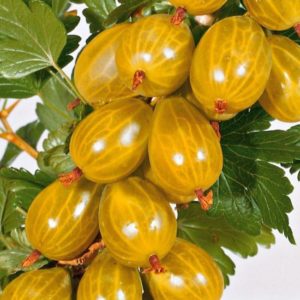
- excellent taste;
- good productivity;
- frost resistance;
- immunity to powdery mildew;
- ripe berries do not crumble;
- the studdedness of the lower part prevents damage by rodents;
- breeds easily.
Disadvantages:
- spreading of the bush in the first year of cultivation;
- sour taste of berries.
Growing technology
Despite the unpretentiousness of the variety, improper care or its complete absence negatively affects the yield.
Optimal conditions
Russian yellow grows best in dry, sunny locations, in low elevation or with good drainage. The soil should be nutritious, not very dense. It develops well on sandy ones, it is desirable to add humus to clayey ones. Shelter from the wind is necessary.
Terms and rules of landing
Saplings are planted in spring or fall. Spring planting is performed in completely thawed ground. Depending on the region, the dates vary from early April to mid-May. It is undesirable to plant at air temperatures above + 20 ° C. In autumn, gooseberries are planted a month before the onset of stable subzero temperatures.
The seedling is placed in a pit filled with humus and fertilizers, spreading the roots along a previously prepared mound. After planting, water abundantly to remove air pockets.
Further care
Young plants need constant, but low humidity. In the absence of precipitation for more than 2 weeks, they need watering - about 10 liters per plant. Fertilizers are applied three times per season: in spring (with a high nitrogen content), in mid-summer and late August. In the southern regions, the last dressing is applied not in August, but in September.
Possible problems, diseases, pests
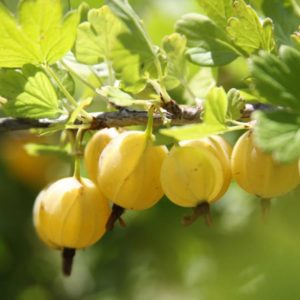
A cold, rainy summer will bring serious problems to gooseberries. An excess of moisture significantly impairs the nutrition of the bush, reducing its resistance to infectious diseases. Anthracnose or other fungal diseases may appear. To avoid trouble, it is advisable to carry out preventive spraying with fungicides.
The greatest harm to the Russian yellow variety is caused by a spider mite. It appears with the arrival of stable heat and multiplies rapidly, destroying foliage. At the first sign of the disease, insecticides are used.
Wintering
In regions where the temperature does not drop below -28 ° C, there is no need to use a special shelter for the winter - there is enough snow cover. Only young plants require protection. The near-trunk circle is spud, the branches are bent to the ground, and covered with spruce branches on top.
In all climates, abundant watering is required before wintering to reduce the risk of freezing.
Reproduction
The variety reproduces well by layering. To do this, in the spring, last year's healthy shoots are attached with staples to the ground, soil is poured on top, after which the earth is compacted. During the season, the soil is poured if necessary. The area in which the roots form must be constantly moist.
Reproduction by cuttings is also possible. To do this, in the fall, planting material is harvested, which is stored in the basement in winter, wrapped in a damp cloth. In the spring, cuttings are planted in light soil, covered with transparent material to reduce moisture loss. Constant humidity is maintained throughout the season. They are planted in the ground next spring.
Important! In conditions of high humidity, fungal diseases develop easily. It is advisable to treat the seedlings with fungicides.
The rarest way is to divide the bush. It is carried out in early spring, before the leaves appear, or in late autumn. The gooseberries are dug up, cut into two or more pieces. Damaged areas are treated with garden pitch or clay mash. Planted as normal seedlings.
Features of cultivation depending on the region
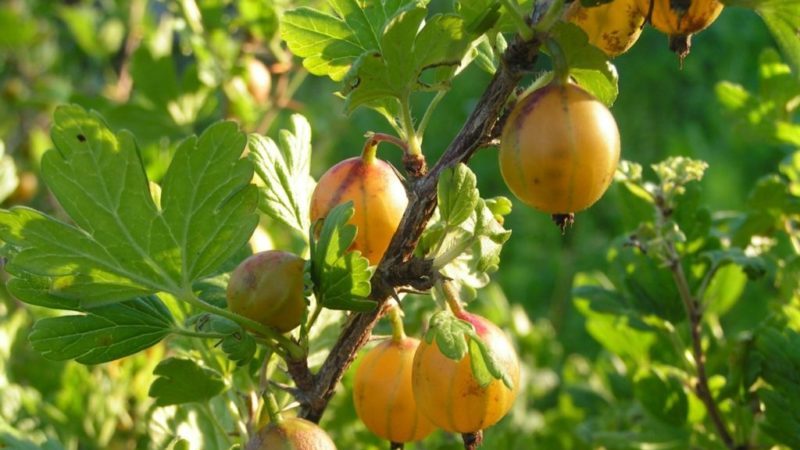
Despite its high drought resistance, in the southern regions, gooseberries can be harmed by temperatures above + 40 ° C in the absence of rainfall for a long time. In addition to weekly watering, mulching is recommended in this case to lower the soil temperature.
Mulch is laid out in the trunk circle in May or June, when the soil warms up and dries up. In case of prolonged rains, the mulching material is raked to the side to improve moisture evaporation and avoid waterlogging.
In the northern regions, the danger for the Russian yellow variety is return frosts in the spring. Bushes protect from them with light film shelters.
Pollinating varieties
Gooseberry varieties Russian yellow self-fertile. But for a higher yield, it is recommended to plant Russian and Plum varieties next to it.
Read also:
An unpretentious gooseberry variety "Yarovaya".
Conclusion
Gooseberry Russian yellow is an excellent choice for a garden plot in almost any region. Southerners value its drought tolerance. Northerners love its ability to withstand low temperatures. These qualities allow you to get a stable harvest with low labor costs.